Did you know almost 60% of North American birds could risk from climate change in winter? Colder temperatures and changing climates make it hard for birds to survive. You can help by making your yard a winter habitat. Provide the right food, water, and shelter. Your backyard will become a haven for them, helping them survive. You’ll also enjoy watching these birds.
Winterizing your backyard does more than prepare for the cold. It supports birds all year. Native plants offer shelter and protect from predators in early spring. Heated bird baths prevent water from freezing. Cleaning birdhouses and getting rid of old nests ready them for winter. Adding songbird borders, leaf mulch, and brush piles create food and shelter spots. Window decals prevent bird crashes. This makes your yard a safe place, even on cold winter days.
Key Takeaways
- Create a winter bird habitat to support local wildlife.
- Use native plants to provide shelter and food sources.
- Install heated bird baths to maintain a water supply.
- Clean birdhouses and remove old nests for winter roosting.
- Construct brush piles for added shelter.
- Apply window decals to prevent bird collisions.
Provide High-Energy Winter Bird Foods
In winter, birds need calorie-dense food to stay warm. It’s important to fill your feeders with high-energy options. Black oil sunflower seeds are perfect. They’re nutritious and many bird types love them.
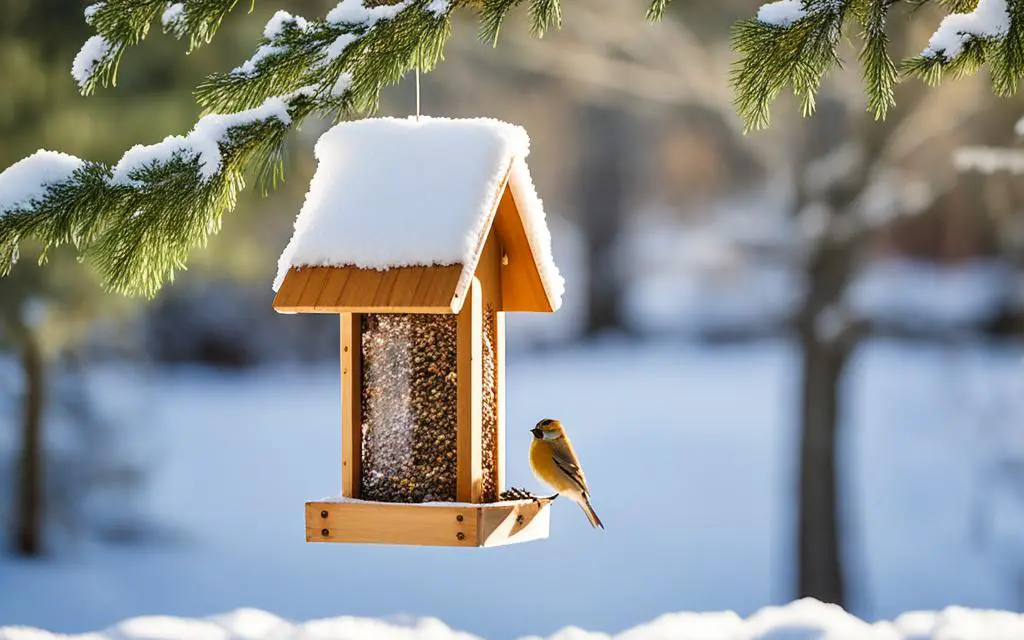
Another great option is suet for winter. Suet cakes give birds the fats and calories they need. They help birds stay warm. You can also use nyjer seeds and peanuts. These foods help different bird types. Keep your feeders clean and full. This will make birds come back for more.
| Type of Food | Benefits | Bird Species Attracted |
|---|---|---|
| Black Oil Sunflower Seeds | High in fat; popular among many bird species | Chickadees, Nuthatches, Finches |
| Suet Cakes | High-energy, crucial fats for warmth | Woodpeckers, Wrens, Juncos |
| Nyjer Seeds | Rich in oils, excellent for small birds | Goldfinches, Pine Siskins, Redpolls |
| Peanuts | High protein and fat content | Blue Jays, Titmice, Sparrows |
I have taken the liberty to link the above items to check out at Amazon. As a reminder, I do receive a small commission through Amazon Affiliates when you make a purchase through the links provided.
High-energy bird foods are key in winter. They help birds through the cold. Your bird feeders will attract colorful birds. A regular feeding routine is a big help to them.
Install Heated Bird Baths and Water Sources
In winter, birds need water but it often freezes. Heated bird baths solve this problem. They offer birds water for drinking and for keeping their feathers in good shape. This helps birds stay warm by managing their body heat well.
Heated bird baths come in many materials that last in cold weather. It’s important to keep the water fresh and unfrozen. You can use immersion heaters with outdoor cords to stop the water from freezing.
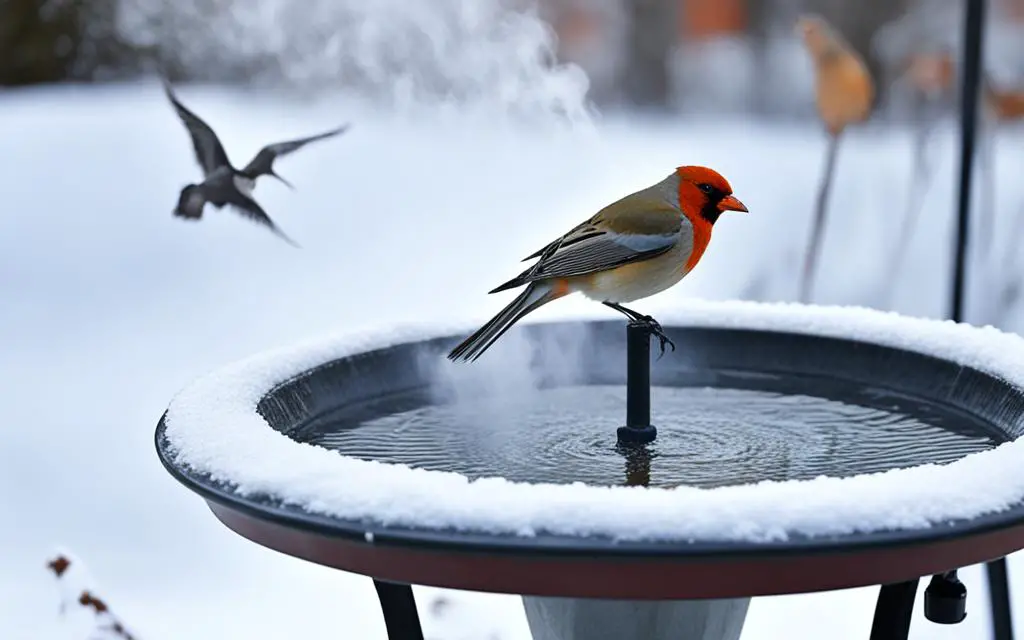
Birds need to bathe, even when it’s cold, to keep their feathers clean. Dirty feathers don’t keep birds warm. So, heated bird baths are key in winter to help birds.
| Benefits | Details |
|---|---|
| Water Accessibility | Ensures birds have a consistent source of water for drinking. |
| Feather Maintenance | Allows birds to bathe, maintaining the insulating quality of their feathers. |
| Survival Support | Heated bird baths aid in supporting birds’ survival during harsh winter months. |
Installing and caring for heated bird baths helps birds a lot in winter. It gives birds a place for water and care, even on cold days. By doing this, we make a welcoming space for birds all winter long.
Create Sheltered Spaces for Roosting
Winter takes away the leaves, leaving birds with less shelter. It’s key to offer new roosting spots to keep them safe. Evergreen trees protect birds from cold winds and enemies.
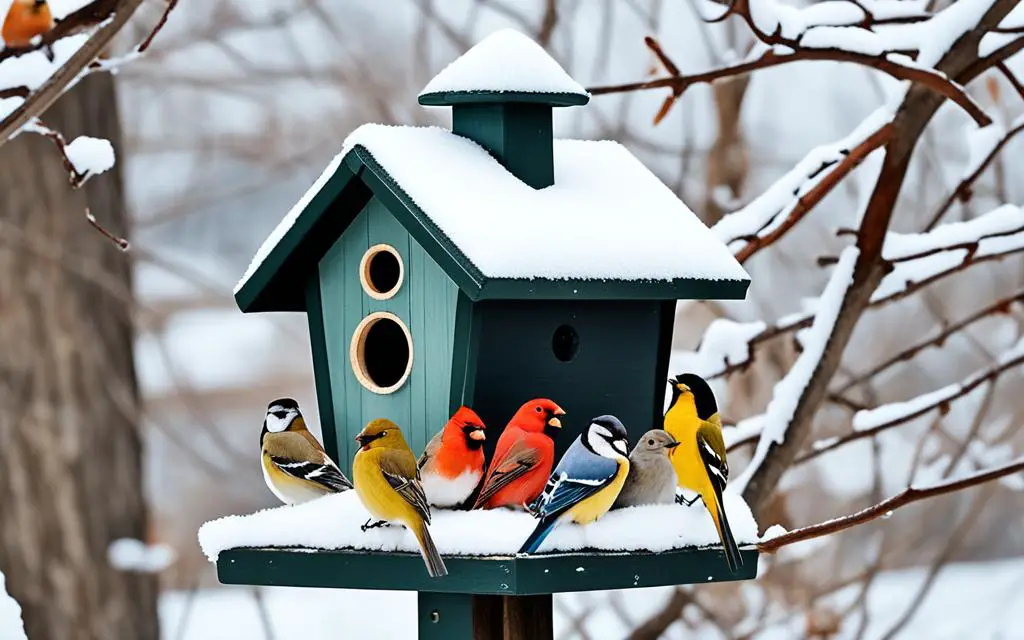
Bird houses give them a cozy place to stay. Fill these houses with wood chips to keep them warm. Switching birdhouses for winter use brings different birds looking for a safe spot.
Brush piles help birds during cold days too. Stacking branches and logs offers them much-needed shelter. This turns your yard into a welcoming place for birds.
| Shelter Type | Benefits |
|---|---|
| Evergreen Trees | Natural windbreaks, predator protection |
| Bird Houses | Insulation, secure and warm spaces |
| Brush Piles | Essential shelter during extreme weather |
Creating bird-friendly areas in winter is important. This helps make sure our yards are safe spots for birds, no matter the weather.
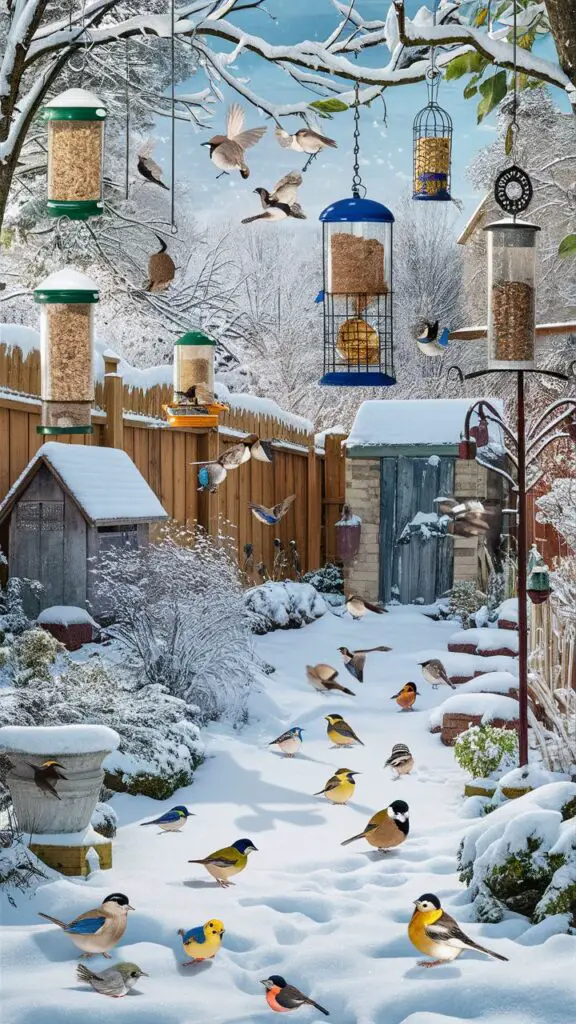
Offer Nesting Materials and Birdhouses
Winter may not be prime breeding time, but birds still need shelter. Offering birdhouses can attract those seeking a safe spot. These houses provide key roosting spaces. They protect birds from the cold and predators. By adding nesting materials and insulation, we make a welcoming place for birds in bad weather.
Insulating birdhouses can be done by adding materials like wood chips. This makes birdhouses warmer and more appealing. An added layer of protection increases warmth inside. It also turns birdhouses into preferred winter spots for many birds. Adding items like yarn, twigs, or leaves helps birds make their spots cozier. It also adds to their security.
Thinking about birdhouse design is also key in winter. Making entrance holes smaller can keep more heat in. This keeps the inside warm and cozy. Well-designed birdhouses and easy-to-find materials can make your yard a haven for birds. This attracts many seeking refuge from the cold. By setting up birdhouses and providing materials, you attract and support birds during winter.
Plant Trees and Shrubs for Winter Cover
The winter months can be particularly challenging for our feathered friends, as food sources become scarce. Providing winter cover in the form of trees and shrubs can prove to be a lifeline for birds during this time. Not only do trees and shrubs offer protection from harsh weather conditions, but they also act as a source of food.
When selecting trees and shrubs for winter cover, it is essential to consider their ability to provide sustenance for birds. Opt for species that produce fruits, berries, or nuts that can be a valuable food source when other resources are limited. These plants not only provide birds with essential nutrients but also play a crucial role in attracting a wide variety of species to your garden.
In addition to planting bird-friendly trees and shrubs, you can further enhance their winter cover by creating strategic feeding areas. Fill your winter bird feeders with birdseed suitable for the cold season, such as options that contain high-fat seeds and grains. Providing mealworms, which are a rich source of protein, can also be beneficial. These supplemental food sources, combined with the natural offerings from trees and shrubs, will encourage the presence of birds in your garden throughout the winter months.
Decorate with Edible Winter Bird Treats
When winter arrives, it can be a challenge for birds to find enough food to sustain themselves. However, you can help by decorating your yard with edible winter bird treats that will attract these delicate creatures. Not only will this provide them with the necessary nourishment, but it will also add a touch of natural beauty to your outdoor space.
One effective way of attracting winter birds is by setting up bird feeders filled with a variety of seeds. Different species prefer different types of seeds, so opting for a mix that includes sunflower seeds, millets, and cracked corn will ensure that you attract a diverse range of winter birds. Additionally, consider offering suet cakes, which are made from animal fat and mixed with seeds. These high-energy treats are a favorite among birds and will help them stay warm during the colder months.
Another key aspect to consider when decorating with edible treats is providing water for birds in winter. While they may be able to find water sources such as unfrozen patches in natural bodies of water, having a birdbath or shallow dish of water can be extremely helpful. To prevent the water from freezing, you can use a small heater or regularly replace the water with lukewarm water. This will entice more birds to visit your yard and keep them hydrated.
As you decorate with edible winter bird treats, don’t forget to include shelled peanuts in your offerings. Birds such as nuthatches, woodpeckers, and jays are particularly fond of peanuts, which are rich in essential fats and proteins. You can scatter them around your yard or place them in specialized feeders to make it easier for the birds to access them. These protein-packed snacks will not only attract a wider variety of birds but also provide them with much-needed sustenance during colder days.
By incorporating these edible winter bird treats into your backyard decorations, you’ll not only be helping our feathered friends survive the harsh winter but also enjoying the pleasure of observing their vibrant colors and lively movements. Plus, you’ll be doing your part in preserving these precious species and strengthening the delicate balance of our natural ecosystem. So go ahead, decorate your yard with tasty treats, and let the beauty of winter birds enchant you throughout the season.
Identify Common Winter Bird Species
During the winter months, many bird species migrate to warmer areas. However, there are several bird species that brave the cold and stick around, making winter birdwatching a delight for enthusiasts. To attract these feathered friends to your backyard, consider winter bird feeding and providing them with bird houses.
The first step in identifying common winter bird species is to set up suitable feeding stations. Fill bird feeders with a variety of seeds, including sunflower seeds, suet cakes, and nyjer seeds, which are particularly attractive to finches. Look out for colorful visitors like the American goldfinch and the vibrant northern cardinal. These birds are not only a joy to watch, but they also add beautiful pops of color to the winter landscape.
While bird feeders are great for attracting birds, providing bird houses can be equally enticing. It’s a common misconception that bird houses are only useful during the warmer months. In fact, bird houses in winter can provide a safe shelter for birds seeking protection from harsh weather. Consider installing bird houses with heaters, designed specifically to keep the inside warm and cozy during cold snaps. This will increase the chances of attracting not only common winter species like chickadees and bluebirds but also more specialized species such as winter wrens and nuthatches.
By combining winter bird feeding with the use of suitable bird houses, you can create a welcoming environment for a variety of delightful winter bird species. Remember to keep your feeders well-stocked and provide fresh water to ensure these winter residents stay happy and healthy throughout the winter season. So grab a warm cup of cocoa, bundle up, and enjoy the beauty of nature as you observe these fascinating birds in your own backyard.
Source Links
- https://www.audubon.org/news/winterize-your-yard-birds
- https://kempkerstruevalue.com/winter-tips-for-feeding-backyard-birds/
- https://www.woodstreampartnerportal.com/articles/winter-bird-feeding-tips

My name is Shane Warren, the author behind Your Bird Buddy – your ultimate guide to the wonderful world of birds! Unleash your inner avian explorer as we delve into a vibrant library of knowledge dedicated to all things feathered. From learning about diverse bird species from across the globe to understanding their captivating habitats and behaviors, I’m here to fuel your passion for these magnificent creatures. Not only that, but I also provide valuable insights on being a responsible and informed pet bird owner. Join our vibrant community and let’s celebrate the feathered wonders of the world together – one chirp at a time. And be sure to join our Your Bird Buddy Community over on Facebook!

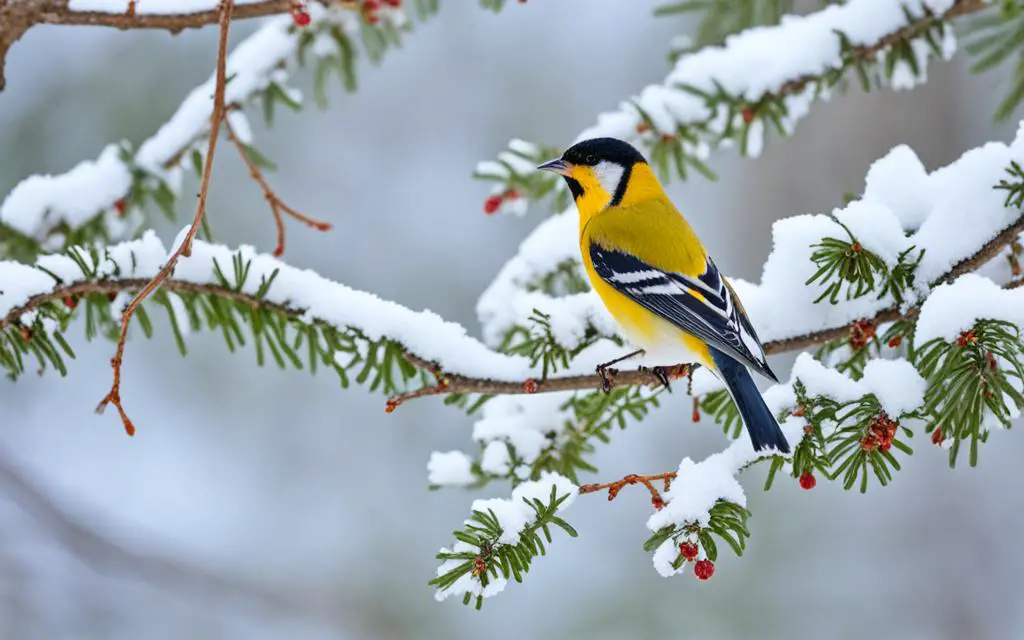
Comments are closed